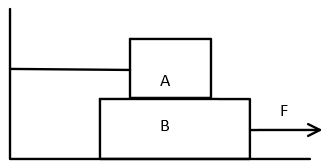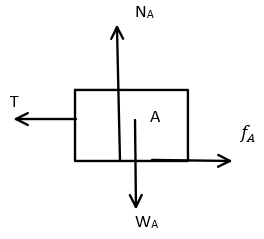
Two blocks A and B placed on a plane surface as shown in the figure. The mass of block A is $100\,kg$ and that of block B is $200\,kg$. Block A is tied to a stand and block B is pulled by a force $F$. If the coefficient of friction between the surfaces of A and B is $0.2$ and the coefficient of friction between B and the plane is $0.3$ then for the motion of B the minimum value of $F$ will be:

(A) $700\,N$
(B) $1050\,N$
(C) $900\,N$
(D) $1100\,N$
Answer
216k+ views
Hint To solve the question, you need to simply make the FBD (Free body diagram) of both of the blocks, block A and block B. The force $F$ should be greater than all the friction forces that are trying to stop the block B from coming into motion. Since there are two surfaces of contact on B, there are two sources of friction instead of only one from the ground.
Complete step by step answer:
As explained in the hint section of the solution, we need to draw the FBDs of both of the blocks.
Let us starts with the FBD of block A first:

As we can see in the diagram, there are four forces acting on the block A:
${W_A}$ is the weight of the block
${N_A}$ is the normal force
$T$ is the tension of the string and,
${f_A}$ is the friction acting on the surface of contact of block A and B.
Since the mass of block A is given to us to be ${m_A} = 100\,kg$
We can conclude that the weight of block A will be
${W_A} = {m_A}g = 100 \times 10 = 1000N$
Since there is no vertical motion of the block A, we can conclude that the normal force is equal to the weight of the block:
${N_A} = {W_A} = 1000N$
The coefficient of friction of the surface of contact of blocks A and B is given to be: ${\mu _1} = 0.2$
Hence, we can say that the maximum friction that can act between the block A and B is:
$
{f_A} = {\mu _1}N \\
\Rightarrow {f_A} = 0.2 \times 1000N \\
\Rightarrow {f_A} = 200\,N \\
$
Now, let us have a look at the FBD of block B:

Here, $W$ is the combined weight of the blocks A and B
$F$ is the external force whose value is asked to us in the question,
$N$ is the normal reaction force,
${f_A}$ is the frictional force between the blocks A and B
$f$ is the frictional force between the block B and the ground.
The mass of block B is given to be ${m_B} = 200\,kg$
So, the combined mass will be: $m = {m_A} + {m_B} = 100 + 200 = 300\,kg$
Hence, the weight of the system becomes:
$W = mg = 300 \times 10 = 3000\,N$
Since there is no vertical motion in the system, the normal reaction force balances out the weight of the blocks, this can be written as:
$
N = W \\
N = 3000\,N \\
$
The coefficient of friction of ground is given to be: $\mu = 0.3$
So, the maximum value of the friction between the block B and ground becomes:
$
f = \mu N \\
\Rightarrow f = 0.3 \times 3000 \\
\Rightarrow f = 900\,N \\
$
Now, for the block to move, the force on the rightwards must at least be equal to the force on leftwards, this can be written as:
$
{F_R} = {F_L} \\
F = f + {f_A} \\
$
Substituting the values of $f$ and ${f_A}$, we get:
$
F = 900 + 200 \\
F = 1100\,N \\
$
As we can see, this matches with the value given in the option (D). So, option (D) is the correct answer.
Note
The most common mistake that many students make is that they take wrong directions of friction between the blocks, this in turn changes the final equation of balancing the forces towards left and right and leads them to a wrong answer.
Complete step by step answer:
As explained in the hint section of the solution, we need to draw the FBDs of both of the blocks.
Let us starts with the FBD of block A first:

As we can see in the diagram, there are four forces acting on the block A:
${W_A}$ is the weight of the block
${N_A}$ is the normal force
$T$ is the tension of the string and,
${f_A}$ is the friction acting on the surface of contact of block A and B.
Since the mass of block A is given to us to be ${m_A} = 100\,kg$
We can conclude that the weight of block A will be
${W_A} = {m_A}g = 100 \times 10 = 1000N$
Since there is no vertical motion of the block A, we can conclude that the normal force is equal to the weight of the block:
${N_A} = {W_A} = 1000N$
The coefficient of friction of the surface of contact of blocks A and B is given to be: ${\mu _1} = 0.2$
Hence, we can say that the maximum friction that can act between the block A and B is:
$
{f_A} = {\mu _1}N \\
\Rightarrow {f_A} = 0.2 \times 1000N \\
\Rightarrow {f_A} = 200\,N \\
$
Now, let us have a look at the FBD of block B:

Here, $W$ is the combined weight of the blocks A and B
$F$ is the external force whose value is asked to us in the question,
$N$ is the normal reaction force,
${f_A}$ is the frictional force between the blocks A and B
$f$ is the frictional force between the block B and the ground.
The mass of block B is given to be ${m_B} = 200\,kg$
So, the combined mass will be: $m = {m_A} + {m_B} = 100 + 200 = 300\,kg$
Hence, the weight of the system becomes:
$W = mg = 300 \times 10 = 3000\,N$
Since there is no vertical motion in the system, the normal reaction force balances out the weight of the blocks, this can be written as:
$
N = W \\
N = 3000\,N \\
$
The coefficient of friction of ground is given to be: $\mu = 0.3$
So, the maximum value of the friction between the block B and ground becomes:
$
f = \mu N \\
\Rightarrow f = 0.3 \times 3000 \\
\Rightarrow f = 900\,N \\
$
Now, for the block to move, the force on the rightwards must at least be equal to the force on leftwards, this can be written as:
$
{F_R} = {F_L} \\
F = f + {f_A} \\
$
Substituting the values of $f$ and ${f_A}$, we get:
$
F = 900 + 200 \\
F = 1100\,N \\
$
As we can see, this matches with the value given in the option (D). So, option (D) is the correct answer.
Note
The most common mistake that many students make is that they take wrong directions of friction between the blocks, this in turn changes the final equation of balancing the forces towards left and right and leads them to a wrong answer.
Recently Updated Pages
JEE Atomic Structure and Chemical Bonding important Concepts and Tips

JEE Amino Acids and Peptides Important Concepts and Tips for Exam Preparation

Electricity and Magnetism Explained: Key Concepts & Applications

Chemical Properties of Hydrogen - Important Concepts for JEE Exam Preparation

JEE Energetics Important Concepts and Tips for Exam Preparation

JEE Isolation, Preparation and Properties of Non-metals Important Concepts and Tips for Exam Preparation

Trending doubts
JEE Main 2026: Application Form Open, Exam Dates, Syllabus, Eligibility & Question Papers

Derivation of Equation of Trajectory Explained for Students

Hybridisation in Chemistry – Concept, Types & Applications

Understanding the Angle of Deviation in a Prism

Understanding Collisions: Types and Examples for Students

How to Convert a Galvanometer into an Ammeter or Voltmeter

Other Pages
JEE Advanced Marks vs Ranks 2025: Understanding Category-wise Qualifying Marks and Previous Year Cut-offs

Units And Measurements Class 11 Physics Chapter 1 CBSE Notes - 2025-26

NCERT Solutions For Class 11 Physics Chapter 8 Mechanical Properties Of Solids

Motion in a Straight Line Class 11 Physics Chapter 2 CBSE Notes - 2025-26

NCERT Solutions for Class 11 Physics Chapter 7 Gravitation 2025-26

Ideal and Non-Ideal Solutions Explained for Class 12 Chemistry




